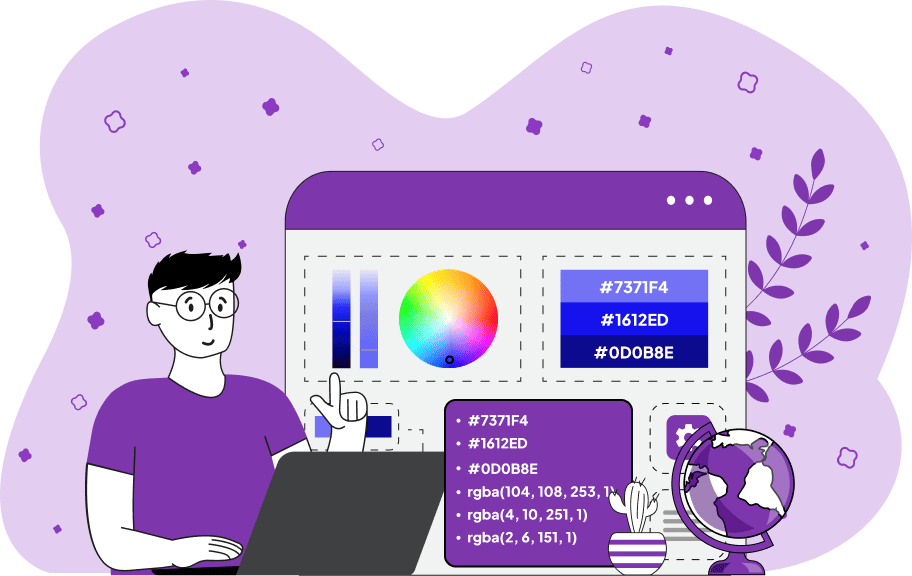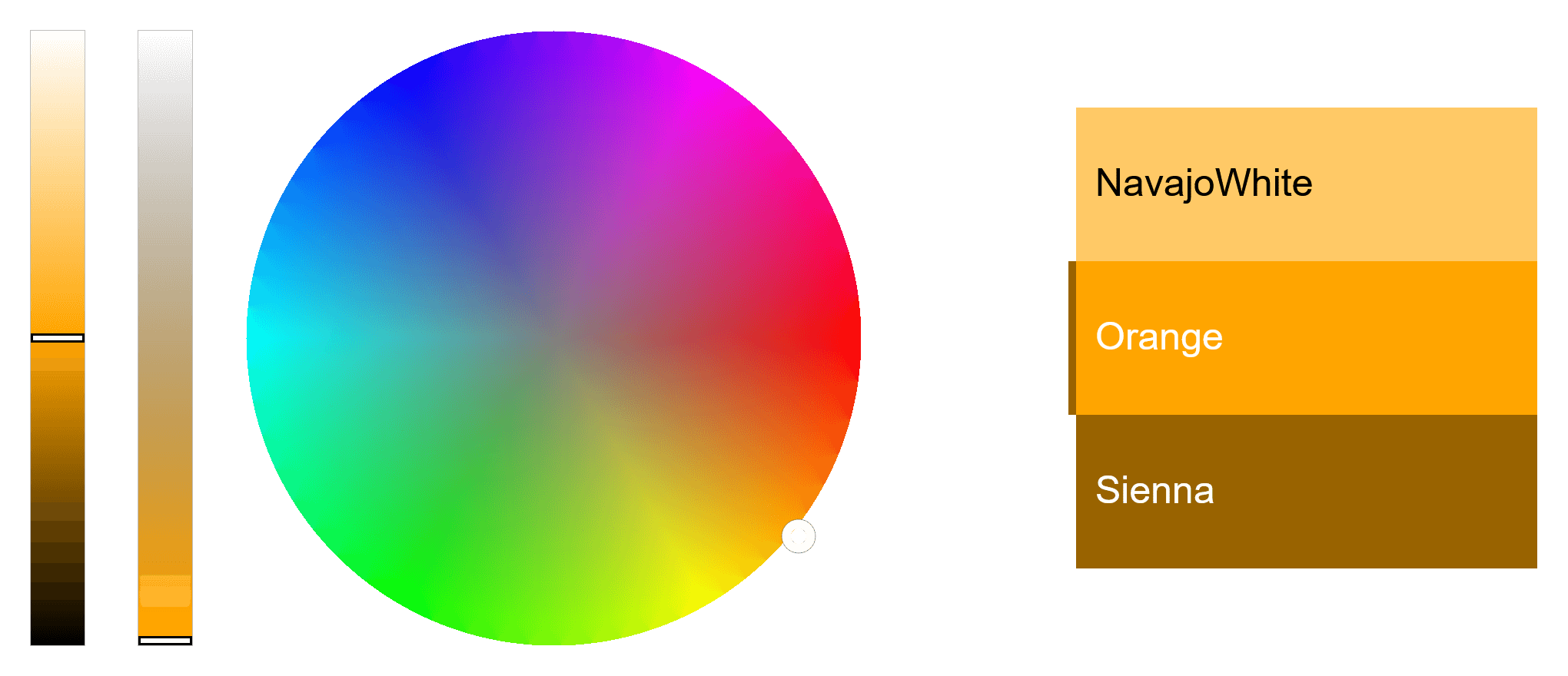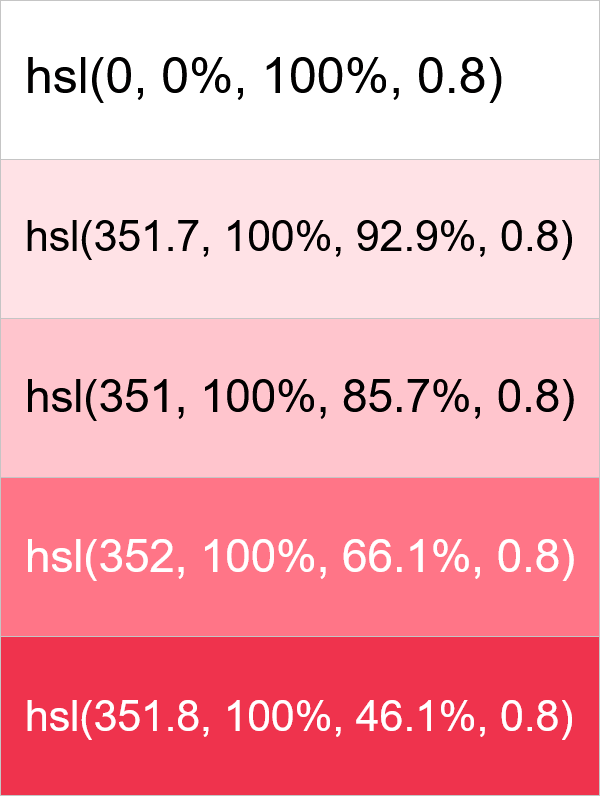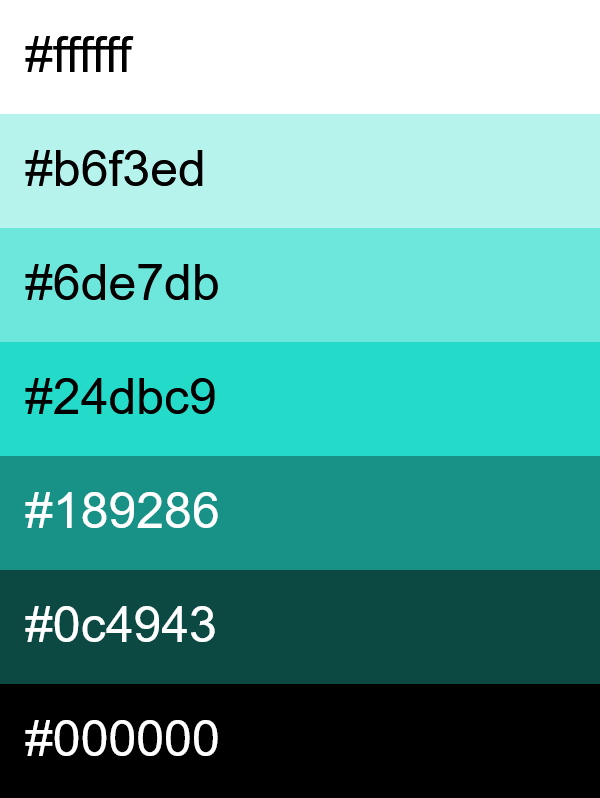World's simplest online monochromatic color palette maker. Just select the initial shade for which you want to create a monochromatic palette, and you'll instantly get a color scheme with multiple similar shades. In the tool options, you can select how many monochromatic colors you need (2–7 colors), adjust the brightness and transparency of the palette, and choose the format for printing the color names or codes of the palette. Free, quick, and very powerful. Press a button – get a monochromatic color palette. Created with love by team Browserling.
World's simplest online monochromatic color palette maker. Just select the initial shade for which you want to create a monochromatic palette, and you'll instantly get a color scheme with multiple similar shades. In the tool options, you can select how many monochromatic colors you need (2–7 colors), adjust the brightness and transparency of the palette, and choose the format for printing the color names or codes of the palette. Free, quick, and very powerful. Press a button – get a monochromatic color palette. Created with love by team Browserling.

This browser-based utility generates a monochromatic color palette based on the given color. A monochromatic palette, also known as a monochrome palette, a same-hue palette, and a single-color palette, includes multiple shades of the same color. For example, for the color "green", some of its similar monochromatic colors would be "lime green" and "sea green". Our tool can generate 2, 3, 4, 5, 6, or 7 close colors for the given hue (you can configure how many in the options). Each color shares the same hue, saturation, and transparency level. The only difference between them is their brightness level (also known as the lightness level). For example, if you select the color "red" on the color wheel and generate 3 monochromatic colors, you'll get red itself (with the code hsl(0, 100%, 50%)), a 20% lighter shade (with code hsl(0, 100%, 70%)), and a 20% darker shade (with code hsl(0, 100%, 30%)). However, if your starting color already has a very high or very low lightness value, the lightness difference between the generated shades might be less than 20%. The color wheel and the lightness and transparency sliders are fully interactive, and they allow you to adjust the base color (initial color). The new colors for the palette are generated automatically by increasing or decreasing the lightness value. An alternative way to specify the base color is through the tool options. Here you can enter the color by its name or code, as well as adjust its brightness and opacity levels in percentages (from 0% to 100%). The generated palette appears in the tool's main panel, next to the color wheel. For your convenience, the program marks the base color in the output palette with a vertical stripe. By default, each color is labeled with its HEX code, but you can choose a different format (such as RGB, HSL, HSI, HSV, LAB, CMYK, and more). You can also remove the labels entirely by selecting the "Hide Labels" option. Several other options allow you to draw borders around each color block to better distinguish them visually. Once the palette is ready, you can download just the monochromatic colors on it as a high-quality PNG image or export the entire tool interface with the color wheel (including the position marker of the base color). Png-abulous!
This browser-based utility generates a monochromatic color palette based on the given color. A monochromatic palette, also known as a monochrome palette, a same-hue palette, and a single-color palette, includes multiple shades of the same color. For example, for the color "green", some of its similar monochromatic colors would be "lime green" and "sea green". Our tool can generate 2, 3, 4, 5, 6, or 7 close colors for the given hue (you can configure how many in the options). Each color shares the same hue, saturation, and transparency level. The only difference between them is their brightness level (also known as the lightness level). For example, if you select the color "red" on the color wheel and generate 3 monochromatic colors, you'll get red itself (with the code hsl(0, 100%, 50%)), a 20% lighter shade (with code hsl(0, 100%, 70%)), and a 20% darker shade (with code hsl(0, 100%, 30%)). However, if your starting color already has a very high or very low lightness value, the lightness difference between the generated shades might be less than 20%. The color wheel and the lightness and transparency sliders are fully interactive, and they allow you to adjust the base color (initial color). The new colors for the palette are generated automatically by increasing or decreasing the lightness value. An alternative way to specify the base color is through the tool options. Here you can enter the color by its name or code, as well as adjust its brightness and opacity levels in percentages (from 0% to 100%). The generated palette appears in the tool's main panel, next to the color wheel. For your convenience, the program marks the base color in the output palette with a vertical stripe. By default, each color is labeled with its HEX code, but you can choose a different format (such as RGB, HSL, HSI, HSV, LAB, CMYK, and more). You can also remove the labels entirely by selecting the "Hide Labels" option. Several other options allow you to draw borders around each color block to better distinguish them visually. Once the palette is ready, you can download just the monochromatic colors on it as a high-quality PNG image or export the entire tool interface with the color wheel (including the position marker of the base color). Png-abulous!
In this example, we create a three-color monochromatic palette using orange as the initial color. The tool generates two additional similar orange colors by keeping the same hue and saturation. The first color is created by increasing the lightness of the original orange color by 20%, and the second color is created by decreasing the lightness of the same original orange color by 20%. As a result, we get "Orange" as the middle hue, "NavajoWhite" as the lighter shade (top color), and "Sienna" as the darker one (bottom color).
This example generates a monochromatic palette of 5 pink shades. The palette includes the base shade with 85.7% lightness (in the middle of the palette), two darker shades with 66.1% and 46.1% lightness (at the bottom), and two lighter shades with 92.9% and 100% lightness (at the top). As you can calculate, the lightness step in the lighter shades is smaller because the lightness of the base color is already quite high (85.7%), and for an even distribution of shades up to 100% brightness, the intervals become more compressed. Each color in the output palette has an outline for clear visual color separation. The color code display format is set to HSL, allowing you to instantly see the lightness value of each color. As the base shade has partial transparency (it is 20% transparent and 80% opaque), the entire palette has the same alpha channel value of 0.8.
In this example, we build a monochrome palette based on the turquoise color. We generate seven tones, which include the turquoise in the center (#24dbc9), three of its brighter tones, and three darker tones. Since the brightness of the initial turquoise color is 50% (producing pure turquoise), we get a linear distribution of brightness for the new colors, going from white to black with a brightness interval of 16.7%.
Edit a PNG in your browser.
Compare two or more PNG images.
Convert a PNG image to an AV1 image (AVIF).
Convert an AV1 image (AVIF) to a PNG image.
Convert a PNG image to a High Efficiency Image File (HEIF).
Convert a Hide Efficiency Image File (HEIF) to a PNG image.
Convert a PNG image to an ICO icon.
Convert a PNG image to a TIFF image.
Convert a TIFF image to a PNG image.
Convert a PNG image to a PIK image.
Convert a PIK image to a PNG image.
Convert a PNG image to a PPM image.
Convert a PPM image to a PNG image.
Convert a PNG image to a BPG image.
Convert a BPG image to a PNG image.
Convert a PNG image to a FLIF image.
Convert a FLIF image to a PNG image.
Convert a PNG image to a Paint.net file.
Convert a Paint.net file to a PNG image.
Convert a PNG image to a Photoshop file.
Convert a Photoshop file to a PNG image.
Convert a PNG image to an SVG image.
Convert a PNG image to an PDF document.
Convert a PDF document to a PNG image (or multiple images).
Convert a PNG image to an EPS file.
Convert an EPS file to a PNG image (or multiple images).
Convert a PNG image to a JFIF image.
Convert a JFIF image to a PNG image.
Convert a PNG image to raw RGB values.
Convert RGB values to a PNG image.
Convert a PNG image to raw BGR values.
Convert BGR values to a PNG image.
Convert a PNG image to raw RGBA values.
Convert RGBA values to a PNG image.
Convert a PNG image to raw BGRA values.
Convert BGRA values to a PNG image.
Convert multiple PNGs to a GIF animation.
Convert an APNG animation to a GIF image.
Convert a GIF animation to an APNG image.
Convert an APNG image to a Webp image.
Convert a Webp image to an APNG image.
Convert an APNG image to an MP4 video.
Convert an MP4 video to an APNG image.
Convert an APNG image to an AVI video.
Convert an AVI video to an APNG image.
Convert an APNG image to a WMV video.
Convert an WMV video to an APNG image.
Extract all frames from an APNG image.
Play a PNG animation (APNG) frame by frame.
Change the playback speed of an animated PNG (APNG).
Change how many times an animated PNG loops.
Reverse the order of frames in an animated PNG (APNG).
Created animated PNGs (APNGs) from input images.
Check if the given PNG file is an animated PNG file (APNG).
Create a sprite sheet from all animated PNG (APNG) frames.
Create an animated PNG (APNG) from a sprite sheet.
Create Excel art from a PNG image.
Randomly distort data in a PNG file to make a glitched PNG.
Find all grayscale pixels in a PNG (grayscale mask).
Find all color pixels in a PNG (color mask).
Invert the alpha channel values in a PNG.
Break a PNG image into multiple pieces.
Generate a slideshow animation from multiple PNGs.
Generate a mosaic wall from multiple PNGs.
Convert a PNG into a hexagonal grid of pixels.
Convert a PNG into a triangular grid of pixels.
Create a Voronoi diagram from a PNG image.
Darken PNG corners compared to its center.
Create multiple reflections of a PNG.
Apply a Bayer filter on a PNG.
Make a PNG look like it was taken via night vision goggles.
Make a PNG look like it's spherical.
Run a PNG through the Mobius Transform.
Convert between RGB, CMYK, HSV, and HSL color spaces.
Convert between 8-bit, 16-bit, 24-bit, and 32-bit PNG depths.
Remove dithering from a PNG image.
Convert a PNG to an ASCII art image.
Convert ASCII art to a PNG image.
Convert a PNG to an ANSI art image.
Convert ANSI art to a PNG image.
Convert a PNG to a Braille art image.
Convert Braille art to a PNG image.
Create a PNG image from the given bytes.
Convert a PNG image to bytes.
Increase the quality of a PNG image.
Extract a 2d slice from a PNG.
Create a PNG that contains all possible RGB colors.
Find all textual information in a PNG image and extract it.
Given any 2D PNG, add 3rd dimension to it.
Quickly erase text (labels, captions) from a PNG.
Quickly delete a watermark from a PNG.
Salvage a PNG that has bad bytes in it and doesn't open.
Conceal a secret message in a PNG image.
Update meta data of a PNG file.
Delete meta data from a PNG picture.
Check if the given file is a valid PNG without errors.
Subscribe to our updates. We'll let you know when we release new tools, features, and organize online workshops.
Enter your email here
We're Browserling — a friendly and fun cross-browser testing company powered by alien technology. At Browserling we love to make people's lives easier, so we created this collection of online PNG tools. We created the simplest possible user interface for our tools and they are now used by millions of users every month. Behind the scenes, our online PNG tools are actually powered by our web developer tools that we created over the last couple of years. Check them out!




